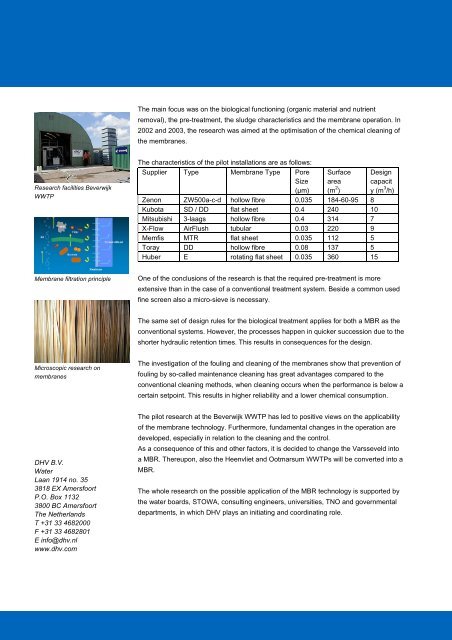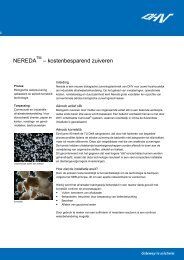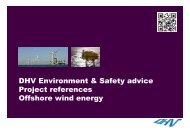MBR Pilot Plant Research Beverwijk The Netherlands - Dhv
MBR Pilot Plant Research Beverwijk The Netherlands - Dhv
MBR Pilot Plant Research Beverwijk The Netherlands - Dhv
Create successful ePaper yourself
Turn your PDF publications into a flip-book with our unique Google optimized e-Paper software.
<strong>Research</strong> facilities <strong>Beverwijk</strong><br />
WWTP<br />
Membrane filtration principle<br />
Microscopic research on<br />
membranes<br />
DHV B.V.<br />
Water<br />
Laan 1914 no. 35<br />
3818 EX Amersfoort<br />
P.O. Box 1132<br />
3800 BC Amersfoort<br />
<strong>The</strong> <strong>Netherlands</strong><br />
T +31 33 4682000<br />
F +31 33 4682801<br />
E info@dhv.nl<br />
www.dhv.com<br />
<strong>The</strong> main focus was on the biological functioning (organic material and nutrient<br />
removal), the pre-treatment, the sludge characteristics and the membrane operation. In<br />
2002 and 2003, the research was aimed at the optimisation of the chemical cleaning of<br />
the membranes.<br />
<strong>The</strong> characteristics of the pilot installations are as follows:<br />
Supplier Type Membrane Type Pore<br />
Size<br />
(µm)<br />
Surface<br />
area<br />
(m 2 )<br />
Zenon ZW500a-c-d hollow fibre 0,035 184-60-95 8<br />
Kubota SD / DD flat sheet 0.4 240 10<br />
Mitsubishi 3-laags hollow fibre 0.4 314 7<br />
X-Flow AirFlush tubular 0.03 220 9<br />
Memfis MTR flat sheet 0.035 112 5<br />
Toray DD hollow fibre 0.08 137 5<br />
Huber E rotating flat sheet 0.035 360 15<br />
Design<br />
capacit<br />
y (m 3 /h)<br />
One of the conclusions of the research is that the required pre-treatment is more<br />
extensive than in the case of a conventional treatment system. Beside a common used<br />
fine screen also a micro-sieve is necessary.<br />
<strong>The</strong> same set of design rules for the biological treatment applies for both a <strong>MBR</strong> as the<br />
conventional systems. However, the processes happen in quicker succession due to the<br />
shorter hydraulic retention times. This results in consequences for the design.<br />
<strong>The</strong> investigation of the fouling and cleaning of the membranes show that prevention of<br />
fouling by so-called maintenance cleaning has great advantages compared to the<br />
conventional cleaning methods, when cleaning occurs when the performance is below a<br />
certain setpoint. This results in higher reliability and a lower chemical consumption.<br />
<strong>The</strong> pilot research at the <strong>Beverwijk</strong> WWTP has led to positive views on the applicability<br />
of the membrane technology. Furthermore, fundamental changes in the operation are<br />
developed, especially in relation to the cleaning and the control.<br />
As a consequence of this and other factors, it is decided to change the Varsseveld into<br />
a <strong>MBR</strong>. <strong>The</strong>reupon, also the Heenvliet and Ootmarsum WWTPs will be converted into a<br />
<strong>MBR</strong>.<br />
<strong>The</strong> whole research on the possible application of the <strong>MBR</strong> technology is supported by<br />
the water boards, STOWA, consulting engineers, universities, TNO and governmental<br />
departments, in which DHV plays an initiating and coordinating role.




